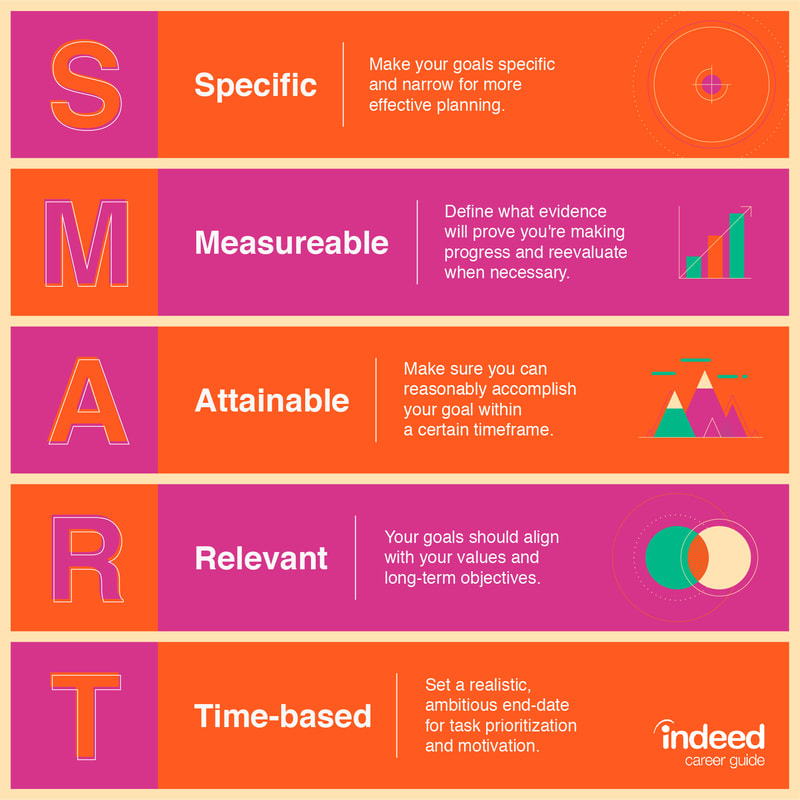Lesson: SMART Goal Setting Framework
Goal setting means identifying a specific objective within a certain amount of time. In sports, goal setting is achieving a level of performance to improve your overall game. You can set near term or long term goals and work on achieving them. Goals usually focus on improving a measurable skill, such as "I will make 80% of my free throws during games, get more deflections, or increase my steals by two per game".
Why is goal setting important? Setting measurable goals is a valuable exercise in sport psychology, which results in higher level of performance, provides focus, encourages effort, and leads to the development of new skills.
Use the SMART goal setting framework. By setting goals and creating a clear roadmap for how you’ll reach your intended goals, you can decide how to apply your time and resources to make progress. Without goals, it can be difficult to determine if you are developing and improving over time.
Setting milestones along the way will give you the opportunity to re-evaluate and course-correct as needed. When you achieve your milestones, remember to reward yourself in small but meaningful ways.
(Specific) Be specific - Put a number on it. Be as clear and specific as possible with what you want to achieve. The more narrow your goal, the more you’ll understand the steps necessary to achieve it. Examples: Deny your player the ball six times per game. Get ten rebounds a game. Get two blocked shots each half.
(Measurable) Be able to measure progress. Setting milestones along the way will give you the opportunity to re-evaluate and course-correct as needed. When you achieve your milestones, remember to reward yourself in small but meaningful ways.
(Achievable) Challenging yet realistic. Setting goals you can reasonably accomplish within a certain timeframe will help keep you motivated and focused. Finding the right balance between pushing oneself without setting yourself up for failure. Example: Become a better player by passing only to an open player .
(Relevant) It must align to your broader objectives.
Consider whether they are important or not when setting goals for yourself. And of your goals should be aligned with your ideals and broader, longer-term goals.
If an objective does not contribute to your larger goals, you might reconsider it. Ask yourself why the aim is important to you, how it will help you to reach it, and how it will contribute to your long-term goals. Example: Make the JV basketball team.
(Time-bound) Set an end date. If you set an end-date, it can help provide motivation and help you prioritize everything you are working on.
Goal Setting Tips
(1) Baby Steps - Use short term goals as stepping stones toward long term goals. Example: Preseason: Add a three point shot to my game. Be more aggressive off the ball. Season - get five assists per game.
(2) Implement strategies to achieve goals - In order to obtain your specific goals, you must develop specific skills for achieving them. This can be broken down to three separate times of year.
(3) Track It - It's utterly critical to track your goals. It needs to be part of your everyday life. Become obsessed with the goal and reaching it.
Example: You can use the Fight ON! Mentality Goal Tracking app to set and monitor your goals. You can also use an index card or construct a graph. Put it in a noticeable spot, such as inside your locker; make a copy and place it during away games in your travel bag.
(4) Evaluate It - Crucial for the ongoing measurement and evaluation of goals. Goals can change over time, with feedback from others, they need to be evaluated by coaches, trainers, and performance specialists. To determine priorities, set daily meeting times.
Example: Meet with coaches on a designated schedule to discuss overall goal progress. You can make changes and edits to the goals as necessary.
Using the SMART goal framework allows you to set boundaries and defines the steps you’ll need to take, resources necessary to get there, and milestones that indicate progress along the way. With SMART goals, you’re more likely to achieve your goal efficiently and effectively. Set SMART (Specific, Measurable, Attainable, Relevant, and Time-Bound) goals, work hard to reach them, never give up, and continue to Fight ON!
Why is goal setting important? Setting measurable goals is a valuable exercise in sport psychology, which results in higher level of performance, provides focus, encourages effort, and leads to the development of new skills.
Use the SMART goal setting framework. By setting goals and creating a clear roadmap for how you’ll reach your intended goals, you can decide how to apply your time and resources to make progress. Without goals, it can be difficult to determine if you are developing and improving over time.
Setting milestones along the way will give you the opportunity to re-evaluate and course-correct as needed. When you achieve your milestones, remember to reward yourself in small but meaningful ways.
(Specific) Be specific - Put a number on it. Be as clear and specific as possible with what you want to achieve. The more narrow your goal, the more you’ll understand the steps necessary to achieve it. Examples: Deny your player the ball six times per game. Get ten rebounds a game. Get two blocked shots each half.
(Measurable) Be able to measure progress. Setting milestones along the way will give you the opportunity to re-evaluate and course-correct as needed. When you achieve your milestones, remember to reward yourself in small but meaningful ways.
(Achievable) Challenging yet realistic. Setting goals you can reasonably accomplish within a certain timeframe will help keep you motivated and focused. Finding the right balance between pushing oneself without setting yourself up for failure. Example: Become a better player by passing only to an open player .
(Relevant) It must align to your broader objectives.
Consider whether they are important or not when setting goals for yourself. And of your goals should be aligned with your ideals and broader, longer-term goals.
If an objective does not contribute to your larger goals, you might reconsider it. Ask yourself why the aim is important to you, how it will help you to reach it, and how it will contribute to your long-term goals. Example: Make the JV basketball team.
(Time-bound) Set an end date. If you set an end-date, it can help provide motivation and help you prioritize everything you are working on.
Goal Setting Tips
(1) Baby Steps - Use short term goals as stepping stones toward long term goals. Example: Preseason: Add a three point shot to my game. Be more aggressive off the ball. Season - get five assists per game.
(2) Implement strategies to achieve goals - In order to obtain your specific goals, you must develop specific skills for achieving them. This can be broken down to three separate times of year.
- Off-season
- Develop enhanced strength training programs to increase physical performance.
- Study game film of your team as well as other teams.
- Talk with more advanced/skilled players and ask for feedback.
- Pre-Season
- Work with a skills coach on techniques, forms, and mechanics.
- Observe the best players in your sports, even professional ones.
- Set specific goals for practice.
- Regular Seasons
- Monitor overall progress and note accomplishments.
- Continue to make refinements to improve skills and strength.
(3) Track It - It's utterly critical to track your goals. It needs to be part of your everyday life. Become obsessed with the goal and reaching it.
Example: You can use the Fight ON! Mentality Goal Tracking app to set and monitor your goals. You can also use an index card or construct a graph. Put it in a noticeable spot, such as inside your locker; make a copy and place it during away games in your travel bag.
(4) Evaluate It - Crucial for the ongoing measurement and evaluation of goals. Goals can change over time, with feedback from others, they need to be evaluated by coaches, trainers, and performance specialists. To determine priorities, set daily meeting times.
Example: Meet with coaches on a designated schedule to discuss overall goal progress. You can make changes and edits to the goals as necessary.
Using the SMART goal framework allows you to set boundaries and defines the steps you’ll need to take, resources necessary to get there, and milestones that indicate progress along the way. With SMART goals, you’re more likely to achieve your goal efficiently and effectively. Set SMART (Specific, Measurable, Attainable, Relevant, and Time-Bound) goals, work hard to reach them, never give up, and continue to Fight ON!

